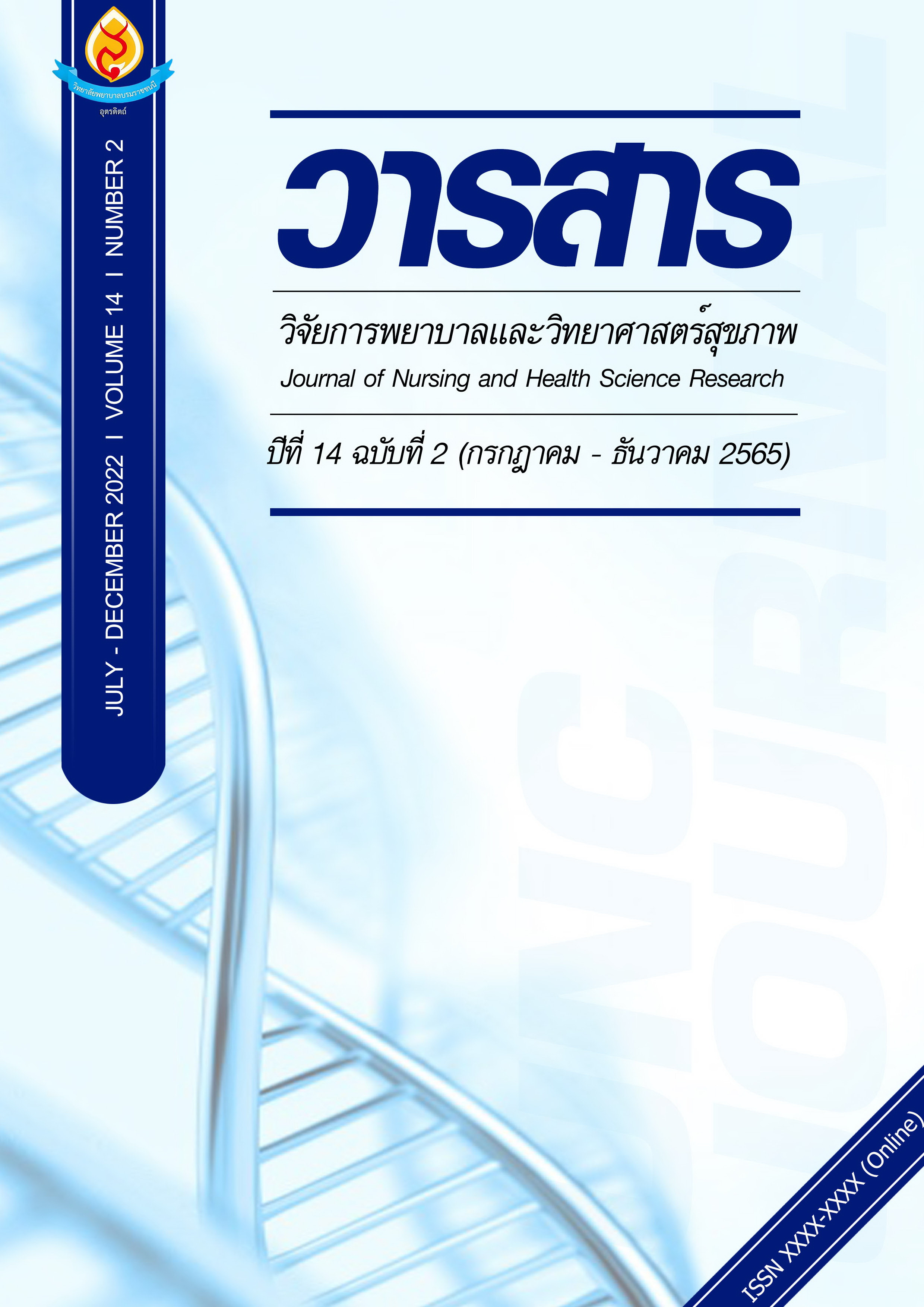ปัจจัยทำนายพฤติกรรมการป้องกันโรคไข้เลือดออกของประชาชนในพื้นที่แนวป่าห้วยขาแข้ง อำเภอลานสัก จังหวัดอุทัยธานี
Main Article Content
บทคัดย่อ
การวิจัยเชิงพรรณนาแบบภาคตัดขวางครั้งนี้ มีวัตถุประสงค์เพื่อศึกษาพฤติกรรมการป้องกันโรคไข้เลือดออกและเพื่อหาอำนาจการทำนายพฤติกรรมการป้องกันโรคไข้เลือดออก กลุ่มตัวอย่าง คือ ประชาชนในพื้นที่แนวป่าห้วยขาแข้ง อำเภอลานสัก จำนวน 391 คน โดยการสุ่มตัวอย่างแบบเป็นระบบ เครื่องมือที่ใช้ คือ แบบสอบถามปัจจัยที่ส่งผลต่อพฤติกรรมการป้องกันโรคไข้เลือดออกของประชาชน มีค่า KR-20 และ ค่าสัมประสิทธิ์อัลฟาของครอนบาค ระหว่าง .75 - .90 วิเคราะห์ข้อมูลโดยใช้สถิติเชิงพรรณนา วิเคราะห์ค่าสัมประสิทธิ์สหสัมพันธ์เพียร์สัน การวิเคราะห์ค่าสัมประสิทธิ์สหสัมพันธ์อีต้า และการวิเคราะห์ถดถอยพหุคูณแบบเป็นขั้นตอน
ผลการวิจัยพบว่า กลุ่มตัวอย่างมีพฤติกรรมการป้องกันโรคไข้เลือดออกของประชาชน อยู่ในระดับปานกลาง (X= 29.48, SD= 5.94) การวิเคราะห์ถดถอยพหุคูณแบบขั้นตอน พบว่า การสนับสนุนทางสังคม (β=.36, p<.001) การมีทักษะในการใช้ทรัพยากร (β=0.05,p<0.001) การมีเปลือกหอยบริเวณบ้าน (β=.069, p<.001) ความคาดหวังในประสิทธิผลของการตอบสนอง (β=.03, p<.001) โอ่งล้างเท้า (β=.02, p=.001) ความพอเพียงของทรัพยากร (β=.01, p=.006) การรับรู้ความรุนแรง (β=.01, p=.002) การรับรู้โอกาสเสี่ยง (β= .01, p=.002) สภาพบ้าน (β=.01, p=.031) และความรู้เกี่ยวกับเรื่องโรคไข้เลือดออก (β=.01, p=.041) สามารถร่วมกันทำนายพฤติกรรมการป้องกันโรคไข้เลือดออก ได้ร้อยละ 54.30
ข้อเสนอแนะจากการวิจัย ควรนำปัจจัยดังกล่าวมาปรับวิธีการปรับเปลี่ยนพฤติกรรมการป้องกัน โรคไข้เลือดออก เพื่อให้เกิดการปรับเปลี่ยนพฤติกรรมที่เหมาะสมและเพิ่มประสิทธิภาพและประสิทธิผลในการป้องกันโรคไข้เลือดออกได้มากขึ้น
Article Details

อนุญาตภายใต้เงื่อนไข Creative Commons Attribution-NonCommercial-NoDerivatives 4.0 International License.
บทความหรือข้อคิดเห็นใดใดที่ปรากฏในวารสารวิจัยการพยาบาลและวิทยาศาสตร์สุขภาพ เป็นวรรณกรรมของผู้เขียน ซึ่งบรรณาธิการหรือสมาคมศิษย์เก่า ไม่จำเป็นต้องเห็นด้วย และบทความที่ได้รับการตีพิมพ์เผยแพร่ถือเป็นลิขสิทธิ์ของวารสารวิจัยการพยาบาลและวิทยาศาสตร์สุขภาพ
เอกสารอ้างอิง
Arjsom, S. (2015). The relation of health belief and dengue haemorrhagic fever behaviors of villagers: a case study of Tayak Sub-district, Muang District, Sakaeo Province. (master’s thesis), Rajabhat Rajanagarindra University. (in Thai).
Bandura, A. (1997). Self – efficacy: The exercise of control. New York: W.H. Freemanand
Becker, M. H. (1974). The health belief model and sick role behavior. Health Education Monographs, 2(4), 409-419.
Best, J. W. (1997). Research in education. (2nd ed ). Englewood Cliffs: NJ: Prentice – Hell.
Bloom, S. B. (1976). Human characteristics and school learning. New York: McGraw-Hill Companies.
Chairattanasakda, S., Wannapornsiri, S., Noosorn, N., & Kanokthet, T. (2013). Factors among people living in outside of the municipality areas, Nakhonsawan Province. Journal of nursing and health sciences, 7(3), 25–36. (in Thai).
Department of disease control. (2017). Surveillance program for prevention and control of communicable disease 2017-2021. Nonthaburi: Ministry of Public Health. (in Thai).
Daniel, W.W. & Cross, C.L. (1995). Biostatistics: a foundation of analysis in the health sciences. (6th ed.). John Wiley and Sons, Inc.
Department of Medical Services. (2013). Guidelines for diagnosis and treatment of dengue fever. Nonthaburi: Ministry of Public Health. (in Thai).
Doloh, O., Seng, A., Kaewsawat, S., Khammaneechan, P. & Waeyeng, D. (2019). Threat perception on dengue fever among students living in on-campus dormitory at a university in southern region of Thailand. Journal of graduate school, 16(75), 118 – 123. (in Thai).
Mattawangkool, C., Ploykaew, P., Tawansereewattana, A., Sitthijard A. & Noisiri, T. (2017). Factors associated with preventive behavior and disease control of dengue hemorrhagic fever among people in the responsible area of Sai–See Subdistrict health promoting Hospital, Samutsakhon Province. (master’s thesis), Siam University. (in Thai).
Muensane, R. & Pumijumnong, N. (2012). Application of geographic information systems in assessing the risk areas of epidemic dengue hemorrhagic fever in Trat province, Thailand. (master’s thesis), Faculty of Environment and Resource Studies, Mahidol University. (in Thai).
Munsatraksaul, B. & Noosorn, N. (2018). Potential of population in hemorrhagic fever Surveillance in repetition epidemic area in Tabua Sub-District Phothalae District, Phichit Province. (master’s thesis), Naresuan University. (in Thai).
Nooykulwong, T. (2015). Preventive behavior related to dengue hemorrhagic fever: A case study in Sadao District, Songkhla Province. (master’s thesis), Songkhla Rajabhat University. (in Thai).
Office of disease prevention and control 3. (2018). Weekly dengue surveillance report. Nakhonsawan: Author. (in Thai).
Rattanapunya, S. (2018). Predictive factors and supported activity with regard to dengue hemorrhagic fever prevention behaviors in for the population in Maerim District, Chiangmai Province. Journal of Science and Technology Faculty, Chiang Mai Rajabhat University, 27(1), 135-148. (in Thai).
Rongtong, A. & Chomson, S. (2019). Factors affecting participation in dengue hemorrhagic fever preventing and control among people in Nongchang District, Uthai ThaniProvince. EAU heritage journal science and technology, 13(1), 147-156. (in Thai).
Rosenstock, I. M. (1974). The health belief model and preventive health behavior. Health Education Monographs, 2(4), 354-386.
Shepard, DS, Undurraga, EA, & Halasa YA. (2013). Economic and disease burden of dengue in Southeast Asia. PLoS neglected tropical diseases, 7(2), 1-12.
Uthaithani Provincial Public Health Office. (2018). Report of population health outcome. Uthaithani: Author. (in Thai).
Uthaithani Provincial Public Health Office. (2018). Dengue situation from disease surveillance reporting system. Uthaithani: Author. (in Thai).
World Health Organization. (2012). WHO Library Cataloguing-in-Publication Data Global strategy for dengue prevention and control 2012-2020.


